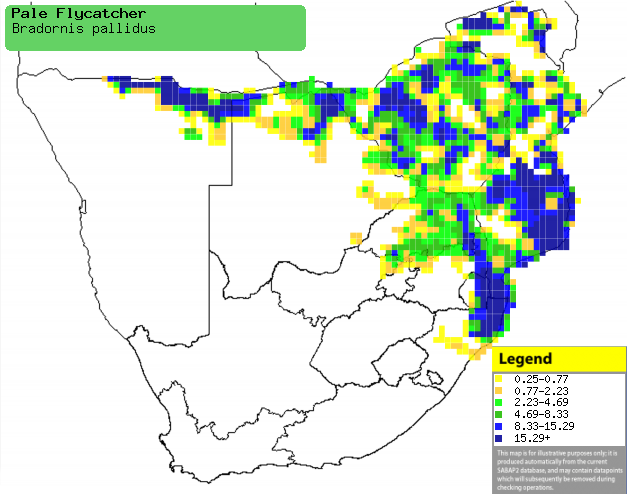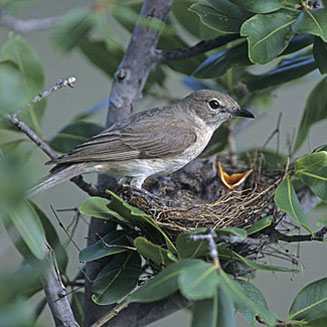|
Bradornis pallidus (Pale
flycatcher,
Pallid flycatcher)
[= Melaenornis pallidus]
MuiskleurvlieŽvanger
[Afrikaans]; Vale vliegenvanger [Dutch]; Gobemouche p‚le [French];
Fahlschnšpper [German]; Papa-moscas-pŠlido [Portuguese]
Life
> Eukaryotes >
Opisthokonta
> Metazoa (animals) >
Bilateria >
Deuterostomia > Chordata >
Craniata > Vertebrata (vertebrates) > Gnathostomata (jawed
vertebrates) > Teleostomi (teleost fish) > Osteichthyes (bony fish) > Class:
Sarcopterygii (lobe-finned
fish) > Stegocephalia (terrestrial
vertebrates) > Tetrapoda
(four-legged vertebrates) > Reptiliomorpha > Amniota >
Reptilia (reptiles) >
Romeriida > Diapsida > Archosauromorpha > Archosauria >
Dinosauria
(dinosaurs) > Saurischia > Theropoda (bipedal predatory dinosaurs) >
Coelurosauria > Maniraptora > Aves
(birds) >
Order: Passeriformes > Family: Muscicapidae
> Genus: Bradornis
Distribution and habitat
Occurs from Ethiopia and Sudan through Tanzania, Angola and
Zambia to southern Africa. Here it is fairly common in Zimbabwe, Mozambique,
north-eastern South Africa, northern Botswana and Namibia. It generally prefers
broad-leaved woodland such as miombo (Brachystegia) woodland, also
occupying arid savanna and Afromontane forest.
|
 |
|
Distribution of Pale flycatcher in southern Africa,
based on statistical smoothing of the records from first SA Bird Atlas
Project (©
Animal Demography unit, University of
Cape Town; smoothing by Birgit Erni and Francesca Little). Colours range
from dark blue (most common) through to yellow (least common).
See here for the latest distribution
from the SABAP2. |
Parasites
A bird in the Caprivi Strip, Namibia was found
with Haemoproteus blood parasites.
Food
It mainly eats insects, doing most of its foraging from a
low perch, from which it pounces on prey on the ground. It may also join
mixed-species foraging flocks, gleaning prey from leaves and branches and
occasionally hawking insects aerially. The following food items have been recorded
in its diet:
Breeding
- The nest is built by the female in about a week, consisting of a cup which
is usually built of long, dark stems of weeds with flower tops, grass,
lichen and dead leaves, usually lined with fine rootlets and feathers. It is
typically placed in between a few twigs in the uppermost branches of a
smaller tree surrounded by larger trees, usually around 2-3 metres above
ground.
 |
|
|
Pale flycatcher at its nest with chick, Sericea
farm, South Africa. [photo Warwick Tarboton ©] |
|
- Egg-laying season is from August-January, peaking from about
September-November.
- It lays 2-4 eggs, which are incubated solely by the female for about 14
days, occasionally taking a break to go and forage.
- The chicks are fed by both adults and are brooded the first five days of
their lives, eventually leaving the nest at about 17 days old. They remain
with their parents for quite a long time, in fact there is one record of a
fledgling only becoming independent at over one and a half years old!
Threats
Not threatened.
References
-
Hockey PAR, Dean WRJ and Ryan PG 2005. Roberts
- Birds of southern Africa, VIIth ed. The Trustees of the John Voelcker
Bird Book Fund, Cape Town.
|
